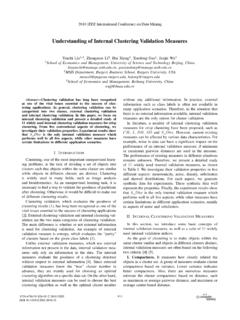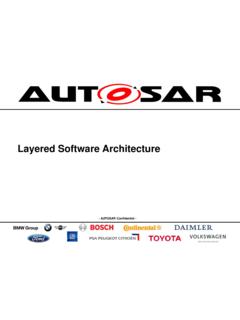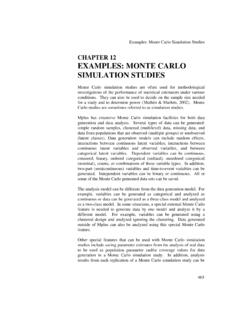Transcription of AN OVERVIEW OF COMMON PARKING ISSUES PARKING …
1 Banerjee & Associates AUGUST 2003 PREPARED FOR: CITY OF PASADENA DEPARTMENT OF TRANSPORTATION AN OVERVIEW OF COMMON PARKING ISSUES , PARKING MANAGEMENT OPTIONS, AND CREATIVE SOLUTIONSP asadena PARKING August 2003 AN OVERVIEW OF COMMON PARKING ISSUES , PARKING MANAGEMENT OPTIONS, AND CREATIVE SOLUTIONS Prepared for City of Pasadena Department of Transportation Report prepared by Banerjee & Associates PARKING is a key component of Pasadena s transportation program. The City has addressed PARKING problems associated with educational institutions, entertainment uses, religious institutions, commercial activities, special events, and most recently the opening of Gold Line Light Rail service. Experience with such programs underscores the need for the City to foster ongoing coordination and cooperation among businesses, institutions, residents, and governmental agencies in order to address PARKING needs in a collaborative manner.
2 The Department of Transportation is conducting a more focused review of PARKING management programs including options for use in residential neighborhoods. The objective of this review is to create, in collaboration with the community, a toolbox of PARKING management solutions that can be used throughout the City to address PARKING problems. This information will be incorporated into a forthcoming community handbook on the City s Neighborhood Traffic Management Program. This briefing material is intended to support and encourage public dialogue on PARKING solutions. BANERJEE & ASSOCIATES Pasadena PARKING August 2003 COMMON PARKING ISSUES With the high percentage of vehicle ownership in the United States, PARKING has become a conflicting and confusing situation for a number of people. Whether at an airport, bus stations and shopping centers, problems with PARKING are an everyday occurrence.
3 Lack of accessible PARKING can hurt local business and decrease the quality of life for residents. Due to the importance of PARKING , cities study and analyze PARKING programs and performance on an ongoing basis. The following list identifies the kinds of problems that typically occur in a community. Inadequate information for motorists on PARKING availability and price. Motorists are likely to be frustrated if they expected abundant and free PARKING but find limited or expensive PARKING , or if they must spend excessive time searching for a PARKING space. Inefficient use of existing PARKING capacity. Local zoning ordinances, building codes, and other development practices can result in an oversupply of PARKING spaces and an inefficient use of existing PARKING . Excessive automobile use. Automobile dependency imposes many costs on society. User costs include reduced travel choices, increased vehicle and residential PARKING costs, and increased accident risk.
4 external costs include increased road and PARKING facility costs, congestion, uncompensated accident damages, environmental degradation, negative land use impacts, and reduced mobility for non-drivers. Economic, environmental and aesthetic impacts of PARKING facilities. Businesses ultimately bear the costs of unpriced PARKING , directly or through taxes that they must pass on to customers. Generous PARKING requirements can constrain businesses in other ways. PARKING spaces that are an inconvenience to nearby residents and businesses. Businesses may experience difficulty in retaining customers and residences may have a problem finding PARKING close to their homes. Demand for handicapped PARKING spaces. These spaces are generally located, in both garages and surface lots, as close to access ramps and curb cuts as possible. Impact of additional PARKING spaces on area traffic and local residents.
5 Existing, severe, spillover problems. When all of the PARKING demand generated by a certain use (or group of uses) is not being accommodated on the site of those uses or within the adjacent on-street spaces. Out-of-town PARKING . The majority of vehicles parked in a residential area are from outside of the neighborhood. BANERJEE & ASSOCIATES PAGE 1 of 12 Pasadena PARKING August 2003 Loading and unloading zones. Scarce PARKING for commercial vehicles to load or unload will cause them to block travel lanes. Inconvenient PARKING options. PARKING within a reasonable walking distance (3 blocks) is hard to find during specific times of the day. Inadequate pricing methods. Many require motorists to prepay based on the maximum amount of time that they may be parked and the price structure used at a particular PARKING space. As a result, motorists often end up paying for time they don t actually use, and if they guess wrong they face a fine.
6 Confusing PARKING policies. Regulations and fees may apply at certain times but not others. PARKING subsidies may be provided to some users but not others. Difficulties with PARKING regulation and pricing. This problem can cause problems, including traffic congestion as motorist cruise for PARKING or stop in a traffic lane to wait for a space, and PARKING congestion in nearby areas. Lack of sufficient PARKING at event site. Special events can potentially disrupt traffic flow and require crowd management. Each event can generate its own unique transportation ISSUES . Low PARKING turnover rate. This can occur when cars are parked in the same space for at least 4 hours (on average). BANERJEE & ASSOCIATES PAGE 2 of 12 Pasadena PARKING August 2003 PARKING MANAGEMENT OPTIONS Although each neighborhood is unique, several PARKING ISSUES and potential solutions are the same. The challenge is to provide adequate PARKING to meet a community s needs for mobility and economic strength, to encourage people to use other modes of travel, and to minimize the impacts of PARKING on neighborhood character.
7 The following recommendations outline several PARKING solutions to consider in order to create a PARKING management system capable of solving existing and future problems. Prioritizing funds. Devoting land and funds to automobile PARKING often reduces the resources available to support other non-auto modes. As a result, policies that increase PARKING supply tend to reduce overall transportation choices. Consider long-term commuter PARKING needs versus short-term. A functional and financial analysis of constructing a PARKING garage or long term surface lot would yield important information for the area as it plans for new development rather than solving the existing condition. Improve information for motorists. Create signs, brochures and other information resources indicating PARKING availability and price. Reduce automobile dependency and encourage transportation alternatives. Improve availability and accessibility of public transport including bus stops and discounted bus fares.
8 Increase the range of PARKING convenience and price levels available to consumers. Strengthen PARKING enforcement by developing more convenient payment and time options. Share PARKING facilities. PARKING can be shared among different business in an area to take advantage of different peak periods. Encourage businesses to share PARKING . For example, businesses with no night-time hours can make their PARKING available for those that have night-time hours. Park once and walk. Focused on centralized, shared PARKING that will create a park once, then walk environment. This is the key in promoting businesses in cities, particularly within central business districts which allows multiple users to reach multiple destinations. Mixed-use PARKING . Require shared PARKING in mixed-use developments and in mixed use areas, since peak demand periods occur at different times. For instance, churches often address their PARKING needs by sharing PARKING with nearby commercial establishments since most churches co-exist with single-family residences and BANERJEE & ASSOCIATES PAGE 3 of 12 Pasadena PARKING August 2003 commercial structures.
9 This works well because religious and commercial uses typically have peak PARKING at different times. Explore opportunities to make greater use of remote PARKING locations and shuttle services. The objective is to have a bus system that would transport a group of people from a remote PARKING structure to their destination. A great example of this is the partnership between a zoo and a shopping mall. During the mall s peak shopping seasons, shoppers have the option to park their cars at the zoo and take the shuttle provided by the shopping mall to the stores. Provide shuttle services to PARKING facilities. In some situations (airports, large entertainment centers, and large commercial centers), shuttle buses may allow longer distances between PARKING facilities and destinations. Advertise shuttle services. It is important to publicizing shuttle services by posting on the Internet, on other nearby community buses and through media targeted to the user groups.
10 Foster coordination and cooperation with businesses, residents, and other governmental agencies to address PARKING needs. Obtain participation from businesses and PARKING management companies with the validation approach where people generally receive either a reduced rate for PARKING or free PARKING for a specified time. This option is attractive when the demand is in off-peak PARKING hours. Address spillover PARKING problems. This difficulty can be addressed by pricing, regulation, and enforcement in areas that experience such problems and compensation to residents who bear negative impacts. In some instances, good neighbor efforts are used. For example, in some communities, residents near high schools and colleges are given free tickets to sport events to compensate for spillover PARKING problems that occur during such events. Preferential residential PARKING zones. To ensure those residents and their visitors will have a place to park in certain neighborhoods, cities may permit the establishment of a preferential PARKING zone.







